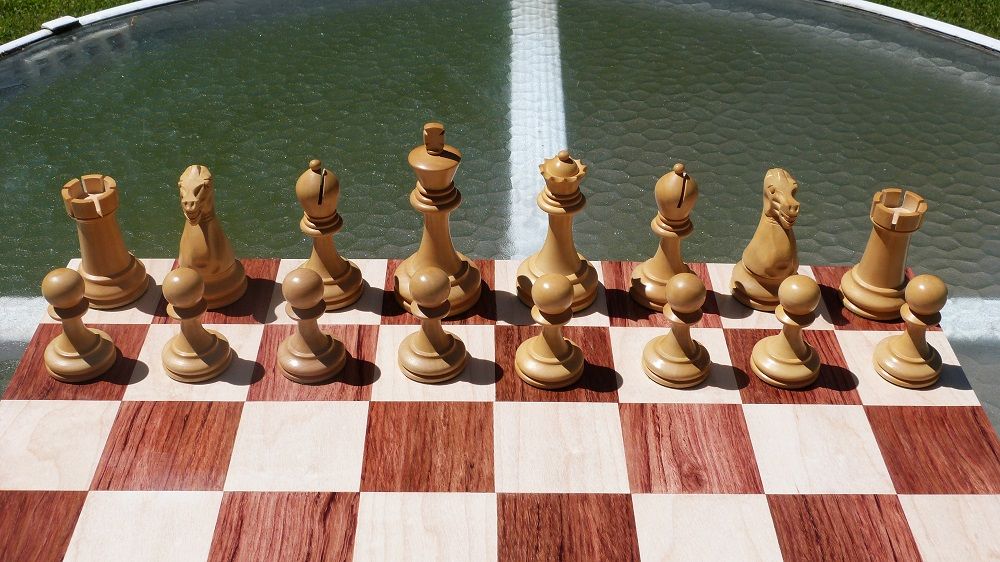Kohpablanca,
Glad to see I'm not the only one interested in the dimensional aspect of sets and boards. I like your work-up. I'll need to take some time to absorb it before commenting.
It was my feeling that since the pawns make up half of all the pieces on the chessboard, I felt the dimensions of the pawns should be considered independent from all the other pieces, except the king. Once the king and pawns are scaled accordingly (the largest and smallest pieces on the board), the remaining pieces can be aesthetically proportioned to 'fill in the gaps.'
You might be interested in the following Linear Slope Design I came up with that uses a constant height differential between adjacent pieces, providing the set with an aesthetically pleasing linear slope.
I've worked up the design for three different size sets:
















Hi All,
So, I’m designing a chess set, and have been researching what makes for good proportions among various chess pieces, and between all the pieces and the board. This site has been really helpful in providing insights into this area - I particularly enjoyed @Loubalch's post, ‘A System for Sizing Chess Pieces and Boards’. I’ve also looked at various reproductions from Chess Bazaar to get an idea of the chess piece sizes of various historic chess sets (I assume they are at least somewhat accurate, if at least proportionately, and if so then the sizing details of each piece has been most informative). And of course I’ve looked at some of the USCF and Fide guidelines on sizing, but given Fide has ignored its own guidelines for its official set (something that still boggles me), I’m not taking these as absolute rules.
It seems that most rules of thumb focus on:
There is also the rule about the bishop being able to pass through the King and Queen when placed on diagonally opposing squares (demonstrated so well by @ifekali - I'd post the link but apparently new members can't post links or pics...!) but this doesn’t really help set the size of the Queen relative to the Bishop per se (the result can be achieved with various sizes of Queen and Bishop, with one being disproportionately larger or smaller than the other).
Leaving aside height for now and focusing on base sizes, there is effectively good guidance for the King and Pawn, some vague guidance for the Queen and Bishop, and no guidance about the Rook and Knight, though I guess Knights (and most Rooks) seem to have the same base size as a bishop.
This has been a bit problematic in designing the right sized chess pieces. This is particularly so because in many chess sets (especially, I think, in the older designs, but I’m happy to be corrected), the King can be substantially bigger than the Queen and subsequent pieces. Similarly, the Pawn can be substantially smaller than the other pieces. This means that even knowing the right size for the King and Pawn, it doesn’t follow that the other pieces should simply be sized in the middle, and / or evenly distributed between King and Pawn.
In the absence of other guidelines, and based on observations of some classic chess sets, plus a little bit of my own subjective aesthetics, I’m come up with some benchmarks for sizing the various chess pieces (with the exception of the King, which seems very well covered). I’d love to get feedback on these; I wouldn’t go so far as to call these benchmarks ‘ideal’, as so much is still down to personal, subjective taste and indeed the seating arrangement and other environmental factors. Rather, it would be interesting if these benchmarks could delineate sets which are a little more on the ‘crowded’ side (preferred, perhaps, in Eastern Europe), vs sets that are less crowded (preferred, perhaps, in Western Europe, from what I can tell); or sets that have, say, pawns or minor pieces that are on the small or large side relative to the rest of the set.
Anyway, the benchmarks I’ve come up with (unless someone else has already formulated something very similar), are:
These benchmarks would seem somewhat arbitrary, but here are some statistics on various sets, based on CB reproduction proportions and stats on the FIDE official set. I included a couple of older style sets like the 1851 Morphy and 1900 Marshall sets, as well as more popular sets like the Lardy, Cavalier, Dubrovnik (of course!) and FIDE, to get a broad representation of styles. 'Target Pawn Size' is what I calculate based on the 2x2 square rule, assuming R+B+N was the width of 2 squares. All measurements in mm, for the base diameter of each piece.
Targ.
P/Sq
Cavalier
Notes:
P = (2√2) / (√2 + 1) x (R+B+N) - R - 2/(√2 + 1) x (B + N)
What do people think? Are these benchmarks reasonable and useful, or am I missing something? (apart from determining suitable heights, which I’ve put off for now).
And what I’m particularly curious about: how do people’s favourite (or least favourite!) sets line up with the proposed size benchmarks? Do they confirm what people like/dislike about various set dimensions?